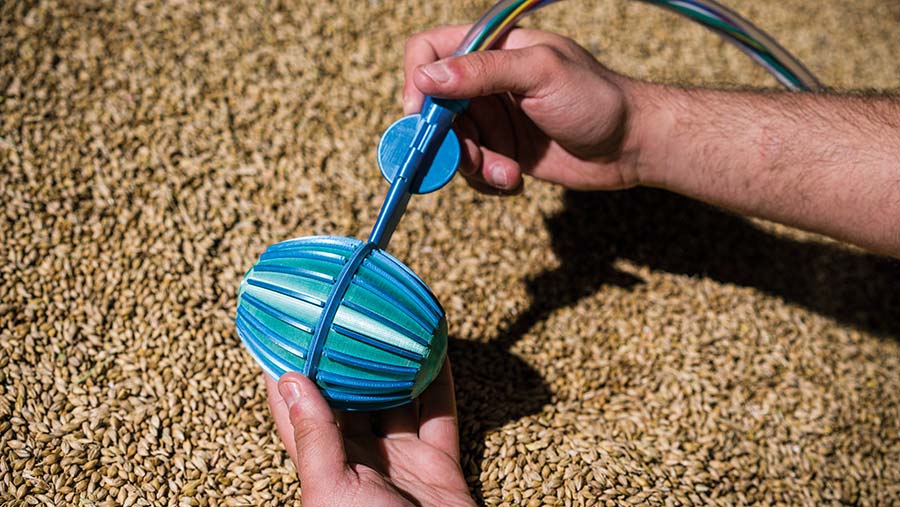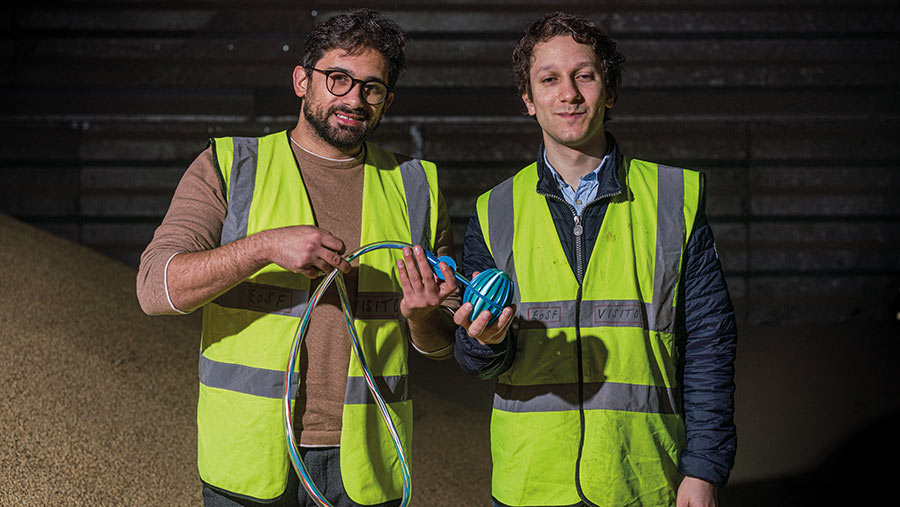How a grain-swimming bot will revolutionise crop monitoring
 © Crover
© Crover Spear sampling grain in the dingy and dusty environment of a grain store could soon be a thing of the past with the imminent launch of a unique grain management tool from Scottish agri-tech start-up Crover.
The rheology-based (study of the flow of matter) PhD of the company’s founder, Lorenzo Conti, provided the inspiration for the revolutionary gizmo.
It revealed a novel physical phenomenon whereby a rotating object in granular substances such as sand, powder or gravel creates a pressure differential around its mass.
This enables it to swim through the material relatively freely.
See also: Automated mobile dryer simplifies harvest for 160ha grower
Following his doctorate at Edinburgh University, Mr Conti looked at opportunities to apply the discovery, and the potential to move small sensors through large stacks of commodity grain was high on the list – leading to the formation of Crover.
Gianlorenzo De Santis joined the team in 2019 and quickly went about gaining an understanding of the current challenges for businesses storing grain.
“A lot of things can go wrong, mainly infestation by moulds and insects. Storage remains one of the main bottlenecks in the supply chain and is the phase that results in the most losses.
“Globally, these are estimated to be 20-30%, and they can be even higher in some countries where infrastructure is poor,” he says.

Gianlorenzo De Santis (left) and Lorenzo Conti © Crover
Investing in modern storage facilities goes a long way to fixing some of the problems, but this isn’t a realistic option for every business or site and makes improving the way grain is managed during storage a key priority.
The process has traditionally been time consuming and labour intensive, with regular store checks and manual sampling with a spear the most common practice.
Workers that have carried out these tasks will know about the health and safety risks, and there is also the potential to miss developing mould or pest issues, which can result in heavy quality losses due to low sampling resolution.
“Grain handling literature says you should ideally sample every 0.5m across the bulk, but if you do that manually it would mean you are in the store for a week, and it is not practical.
“The current monitoring probes [that automate the process] are static, so only monitor a small portion of the grain. In a bulk store, that might be every 5-10m,” explains Mr De Santis.
This is where Crover’s new technology steps in.
Grain-swimming bot
The firm has created a probe that swims through the grain, with on-board sensors gathering temperature and moisture data.
This can be done at a higher sampling resolution than is practically possible with a spear.
“The idea is to use the probe to provide a 3D map of the temperature and moisture across the whole bulk, so they can see the condition of the grain and how it is evolving over time,” says Mr De Santis.
Early intervention could mean increasing ventilation, applying fumigants, or selling problem stocks early before losing value.
With energy prices very high, nipping issues in the bud swiftly could also save storage costs.
In organic systems, early insights are arguably more useful, as there aren’t the options of fumigation or pesticides to control mould and insect infestations.
How does it work?
Crover’s demonstration unit is a much smaller version of what users will see in their grain stores but encompasses similar technology.
Resembling a futuristic judge’s gavel, the device has two dome-shaped independent electronic drive wheels that contain multiple retractable fins. Moisture and temperature sensors are encased within.
The direction and speed of the wheels, along with the position of the retractable fins, allow the device to accurately navigate through the grain or other material in a bulk stack.
Unlike the mini demo unit, which is battery powered, the first commercial version of the system – Crover V1 – will have three components, one of which is a base station plugged into a three-phase power supply.
This is connected to a moon buggy-type robot, which moves the probe to each sampling point on top of the grain.
The probe – made from 3D printed parts – is then attached to this robot by a cable, not only to power its motors and sensors, but also to ensure it doesn’t get lost as it burrows.
It can currently reach 1m in depth but, unlike a spear, the operator doesn’t need to work for long periods on top of the grain bulk manually sampling, as the surface robot and probe are controlled remotely from one spot.
Connection between the robot, probe and control box at the power station is via wi-fi, with the data transferred from there to a cloud server.
Users can then view various data charts on the SavingGrains web portal.
The 3D visualisation that slices and dices the bulk in layers is already enabled and the value of this analysis will increase when working depth is extended to 8m or more.
The system is set to be launched imminently, but updates to both hardware and software are likely to arrive quickly as experience of use in commercial situations increases and areas for refinement are identified.
One example is automation, with the final vision being a robot that can navigate itself around the grain bulk by itself based on set parameters, using base stations as reference points.
Once positioning is automated, Mr De Santis says it will be able to quantify the amount of grain left in a store and novel sensor technology currently being tested will provide data on grain quality, such as mycotoxin levels.
Further down the line, it’s also hoped the probe will spot insect infestations at the larval stage, when pests are often inside the grain kernel and almost impossible to detect.
Subscription model
The system is currently calibrated for use in barley, wheat, and paddy rice, with work ongoing to set it up for several other grains, such as oilseed rape.
Until now, the focus has been on developing it for flat storage in a range of buildings common across Europe, but the company aims to offer its technology in silo systems soon.
It is expected that Crover will be available via a subscription service, where users will be leased the hardware and have access to the SavingGrains web portal for data interpretation.
Costs are yet to be confirmed but grant funding should be available to ease the initial outlay for farm businesses.

